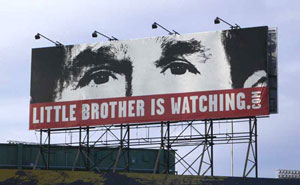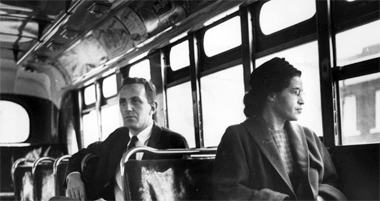transport

Behind the Truck

Delivery truck today in NYC on 5th ave and 19th street.
Rosa Parks

Lots of blogging and news today about the passing of Rosa Parks today at age 92. Google’s blog search shows well over 15,000 blog posts, so I’m not sure I have much to add. Still, I want to point to both her own words and the organizational context which seems absent from most versions of the story.
This morning Democracy Now today aired an interview with her from 1956, a year after the incident, and shortly before the end of the bus boycott. From it I learned a couple of things:
She was not actually at the front of the bus, but at the front of the ‘Negro section’ of the bus. The routine was that when the ‘white’ part was full, black passengers were expected to give up their seats and stand so that whites could sit.
She was not some young radical, but a full 43 when she refused to stand. Rev. King, on the other hand, was all of 26 that winter.
It was not just her civil disobedience and arrest, but the story of it that catalyzed the larger action. She was not the first to refuse her seat nor to be arrested for it, but the timing was right. Her arrest came just months after the lynching of Emmett Till. At the time, the Women’s Political Council was building a case to challenge Jim Crow laws. The organization had been working for ten years to fight the mistreatment of black bus riders.
Mrs. Parks had been involved with the organization and with the broader civil rights movement, in NAACP and with her church. She was helping prepare for a major NAACP youth conference at the time of her arrest. I suspect her involvement with these networks helped spread the word. The Women’s Council distributed 35,000 flyers urging blacks to boycott the buses on December 5, the day of Mrs. Parks’s trial.
In her own words:
“The driver said that if I refused to leave the seat, he would have to call the police. And I told him, ‘Just call the police.’ He then called the officers of the law. They came and placed me under arrest, violation of the segregation law of the City and State of Alabama Transportation. I didn’t think I was violating any. I felt that I was not being treated right, and that I had a right to retain the seat that I had taken as a passenger on the bus. The time had just come when I had been pushed as far as I could stand to be pushed, I suppose. They placed me under arrest. And I wasn't afraid. I don't know why I wasn’t, but I didn’t feel afraid. I had decided that I would have to know once and for all what rights I had as a human being and a citizen, even in Montgomery, Alabama....
And Monday morning, when the buses were out on the regular run, they remained empty. People were walking or getting rides in cars with people who would pick them up, as best they could. On Monday night, the mass meeting at the Hope Street Baptist Church had been called. And there were many thousand people there. They kept coming, and some people never did get in the church, there was so many.
I was not the only person who had been mistreated and humiliated. I have been refused entrance on the buses because I would not pay my fare at the front and go around to the rear door to enter. That was the custom if the bus was crowded up to the point where the white passengers would start occupying. I hadn’t thought that I would be the person to do this. It hadn’t occurred to me. Others had gone through the same experience, some even worse experience than mine, and they all felt that the time had come, that they should decide that we would have to stop supporting the bus company until we were given better service. And the first day of remaining off the bus had been so successful. It was organized, in that we wouldn’t ride the bus until our request had been granted.”
During the boycott Mrs. Parks was unable to find work in Montgomery — no one would hire her. She moved to Hampton, Virginia and ultimately to Detroit with her husband.
The photo above was taken while she sat on a bus in front of the Supreme Court in November 1956, awaiting the decision that would find segregation on transportation unconstitutional.
Rest in peace, Mrs. Parks.
Retool
Folks in Maine have a plan to fight the war by saving jobs — and the environment.
 Christie Toth reports in the April 1, Portland Phoenix about a statewide, grassroots campaign to convert Maine’s military manufacturing infrastructure to environmentally sustainable, non-military manufacturing:
Christie Toth reports in the April 1, Portland Phoenix about a statewide, grassroots campaign to convert Maine’s military manufacturing infrastructure to environmentally sustainable, non-military manufacturing:
“A year ago, Bath Iron Works, Maine’s largest private employer, had a contract to build seven DD(X) Destroyers for the United States Navy.
Now, the president’s budget proposal has slashed the destroyer order by more than half, and the Navy is considering giving the entire contract to a shipyard in Mississippi. As the Maine delegation fights what may be a losing battle on the Hill, economic conversion is beginning to look like more than an idealistic pipe dream. It is beginning to look necessary for Midcoast Maine’s economic survival.
With more than 6200 employees, BIW is Maine’s largest private employer; however, despite a robust shipbuilding schedule, the yard has been hemorrhaging jobs for years. Over the last six months, with 51 layoffs here, another 137 there, BIW has eliminated nearly 500 positions. And those layoffs barely register compared to what the company, a subsidiary of the Virginia-based General Dynamics Corporation, may be facing in the near future....
The Maine congressional delegation is doing everything in its power to push against the carrier-like momentum of Donald Rumsfeld’s vision for leaner, meaner armed forces. Senators Snowe and Collins warn of the grave dangers of single-source destroyer construction in Mississippi, citing everything from terrorist attacks to hurricanes. Congressman Tom Allen rails about the costs of the Iraq war, which he says could purchase a destroyer a week. None of Maine’s elected representatives has been above a little fear-mongering about China....
Peace Action Maine (PAM) is a nonprofit activist organization working to provide ‘a voice of education and a center for all people committed to disarmament and creative responses to conflict.’ On April 1, they will launch a two-year campaign to shift Maine’s manufacturing base away from reliance on military industry. While PAM would support the introduction of any socially responsible, ecologically sound nonmilitary manufacturing in Maine, their most treasured vision is to make Maine a national leader in the production of sustainable energy technologies, such as solar panels and wind turbines.
Domestic demand for windmill equipment is growing. ‘Maine’s going to be left behind,’ says Gagnon, ‘because the Maine delegation is clinging to a sinking boat.’”
The campaign kicked off with a parade in Portland, a traveling art exhibit, public presentations, and the commission of a feasibility study from Economists for Peace and Security.
Bruce Gagnon is blogging the campaign at Organizing Notes.
Call for Artwork: Critical Mass
 The daughter of a friend was arrested during the Republican National Convention. Her crime: riding her bicycle.
The daughter of a friend was arrested during the Republican National Convention. Her crime: riding her bicycle.
She was one of 5,000 people who rode with Critical Mass that clear August evening, and one of 250 arrested. She spent 25 hours in jail for riding her bike in support ecology, fewer cars, and a more bicycle friendly city.
“She lost a bit of innocence that summer,” says her mom.
Since the RNC, the New York Police Department have continued their campaign of intimidation and harassment, arresting riders and seizing bikes despite a court order. Now the Department is suing Time’s Up!, a nonprofit environmental group, to prevent them from participating in and promoting the rides and to enforce the ban on assembly of 20 or more people in a park without a permit.
The folks at Visual Resistance are facilitating a street art campaign in support of Critical Mass and are calling for designs. They hope to produce materials before the April 29th ride.
They will make the designs available for download and have a few printed. Some suggested themes include supporting/promoting Critical Mass; defending the right to free assembly; and promoting bicycling as a form of transportation.
For more info on Critical Mass and harassment by NYPD, visit the Time’s Up press room.
Poster designs should be 8.5x11 or 11x17 inches, sticker and stencil designs can be any logical size. Find out more.
Keep On Truckin’
Reader Kristin from Minneapolis writes:
 “Yesterday I joined a picket line for a local laborers’ union that is on strike against the Minneapolis Public Housing Authority and I saw one of our newest tools: the local Teamsters have a huge semi truck trailer that they drive up and park near picket lines. This one was brightly lit with labor support banners and some Xmas lights. Absolutely necessary this close to solstice when at 7 a.m. the city is still pitch dark.
“Yesterday I joined a picket line for a local laborers’ union that is on strike against the Minneapolis Public Housing Authority and I saw one of our newest tools: the local Teamsters have a huge semi truck trailer that they drive up and park near picket lines. This one was brightly lit with labor support banners and some Xmas lights. Absolutely necessary this close to solstice when at 7 a.m. the city is still pitch dark.
Back during the Hormel strike in the ‘80s, labor supporters ‘used’ trucks at picket lines, but they were the kind that would ‘suddenly’ break down in front of the plant gates and take a while to be used. This is a new twist on that idea, I think.
A quick search on the web netted me this image from Denver.”

